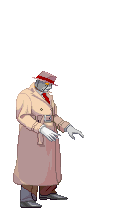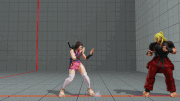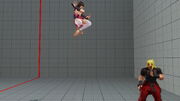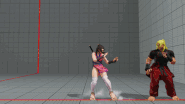
Sprite of Q jumping.
A Jump is a basic gameplay movement in Street Fighter games.
Description[]
A Jump is a multi-utility option in every Street Fighter game since the original. It allows the user to move forwards, backwards, or jump neutrally. Defensive options tend to be rare in the main series, In Alpha a jumping character could block and in III, while the jumper can not block, they can Parry.
The distance and height of a jump is on a character by character bases, Ibuki for example jumps much higher than Abigail. During the entire sequence of a jump (aside from the recovery frames) the character is considered in an "airborne state" a state where they will be Air Reset if they are hit by a non jiggling attack, and can not be hit by grabs. It should be noted that having airborne frames does not mean a jump, such as Ibuki's Hammer Kick or Ryu's Tatsumaki.
Stages of a jump[]

Ibuki's 4 pre jump frames of her neutral jump.
- Pre-Jump frames. Every character has pre-jump frames that they have to go through before going into the air. These frames can be Canceled, a trait that can be taken advantage of by characters such as Ibuki and C. Viper (alongside Super Jump cancels). During these frames the jumping character is considered "Airborne" and can not be grabbed, but is still hit as grounded by normal attacks.
- Jump Acceleration, ascent. Jump Acceleration is how fast characters go high into the air, reaching their apex. Characters with high jump acceleration tend to (but not always) have high jump apexes. Jump Acceleration tends to be great for escaping pressure.

Ibuki at the apex of her neutral jump
- Apex, Ceiling. The Apex of the jump is how high the jump reaches, characters that have very high apexes tend to not be able to pressure off their jumps well (especially neutral jumps) but tend to be great air to air. Characters with low apexes tend to be good at pressuring with their jumps, but struggle to get over some Projectiles and tend to lose air to air against other characters.
- Hangtime, this refers to the amount of time the jumping characters stays at the apex of their jump before starting to descend. Usually high jump acceleration characters have less hang time than slow ones.
- Descent. This is how fast characters tend to go down after reaching their jump apex.
- Recovery, This happens when the character that jumped reaches the ground, in modern games there is usually four frames. Also in modern games the last two recovery frames of the four become "blockable", meaning that technically still recovering and not able to perform actions, they can still block in the two blockable recovery frames. This benefit only applies if the user does not perform an action during the jump. If a user does an attack they will have to deal with the full four recovery frames.
Tactics[]

Ibuki forward jumping
In Street Fighter there are three kind of basic jumps. Forward jump, neutral jump, back jump. All kind of jumps share some basic elements such as putting the user in an airborne state, avoiding fireballs, and move the user in a trajectory that can not be altered. In games where jumping has no defense available, jumpers can be anti aired by specials such as Shoryuken, Unique Attacks such as Agemen, and anti air normals such as Poison's crouching hard punch. Furthermore some specialized attacks such as air throws like Tobizaru, anti air throws such as Soul Throw, and some Super and Ultra combos such as Siberian Blizzard are made to hit only the airborne frames a jump causes. Making jumping more of a risk against some characters than others.
Jumping has multiple uses, advanced players tend to jump to test the reflexes of their opponent. Anti Airs from many characters, such as Rolento's do not do much damage, making jumping a "challenge of sorts". Jumps allow for stronger damage called "Jump In" attacks. These attacks on average do more damage than their grounded counterparts (with some exceptions) and do not deal with pushback. Furthermore some characters can alter the arc of their jumps, such as Ken Masters, who can alter his trajectory with his hurricane kick. Making anti airing against these characters a gamble of sorts where they might be able to punish anti airs that would usually work.
Types of Basic Jumps[]
In Street Fighter there are three types of basic jumps available to all characters.
- Forward Jump: The user jumps forward at a set distance. The distance, and frame data vary from character to character. This type of jump is usually attempted as a sort of approach, especially against Projectile users, and is usually the easiest to anti air. Forward Jumps are also used for high damage post Stun combos and for Option Select.
- Neutral Jump: The user jumps upwards with no horizontal movement. The apex and the overall time of the jump varies from character to character. Characters with low height apexes tend to benefit the most from this type of jump. Neutral jumps are usually used to try and bait attacks that move the opponent forward. Neutral Jumps are commonly used for Safe Jumps and Option Selects. They also tend to be used against command grabs and are a little harder to anti air than their forward jump equivalent. In some games the set of normal attacks available to a jumper using this option is different than their horizontal equivalents.
- Back Jump: The user jumps backwards a set distance. Back jumps are mainly use to disengage the opponent. In specific games, back jumps tend to have specific usage such as punishing Rolls in Street Fighter X Tekken. Characters like Hugo can jump back and still pressure his opponent due to his jump arc and long reaching attacks.
Special types of jumps[]
While rare, Street Fighter offers different style of jumps.
Super Jump[]
- Super Jumps are a mechanic where a character can press down and up in quick succession. The character then proceeds to do a jump that has longer startup, a longer completion sequence, longer horizontal distance, a higher jump apex, and longer recovery. Super Jumps tend to have a similar ability to regular jumps in attacks that can be canceled into the mechanic can then cancel the pre-jump frames into other actions.
Special Jump[]

Ibuki's hard kick Kasumi Gake is a special jump.
Special jumps are jumps that are enabled by Special Attacks. These tend to (but not always) have restrictions in what they can be cancelled into. They also can be Special Canceled from normal and unique attacks that have the attribute available. Cammy's Hooligan Combination can only be cancelled into select options while Ibuki's Kasumi Gake can use any attack available to her. Unlike regular jumps and Super Jumps, Special Jumps can not be cancelled at their pre-jump frames.
V-Skill Jump[]

Chun-Li's V Skill is a jump.
A rare mechanic is a V-Skill that enables jumping. Similarly to Special Jumps they tend to have their own rules and restrictions. Like Special Jumps the pre-jump frames can not be cancelled. These also tend to have side benefits that their special counterparts do not, such as Chun-Li's V-Skill hitting and potentially juggling an opponent while ascending while the visually similar hard kick Kasumi Gake does not have such a benefit.
Wall-Jump[]
- Wall Jumps tend to be rather rare in the series aside most unique jumps. There are two kind of wall jumpers, natural wall jumpers such as Guy and Vega can jump off the wall in standard gameplay with their back to the stage Corner. Unnatural wall jumpers are those that can only do it off one aspect of their entire character kit such as Makoto with her Ultra 2.
Trick Landing[]
- Exclusive to Rolento, by pushing down medium kick during his jump descent Rolento will land on his fighting weapon rather than on his feet and this allows him to either delay his landing or bouncing forward or back.



